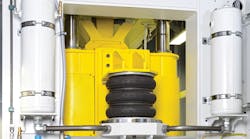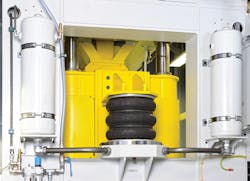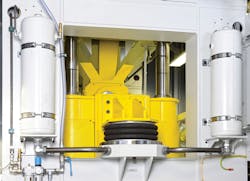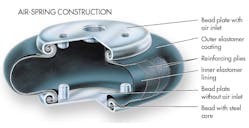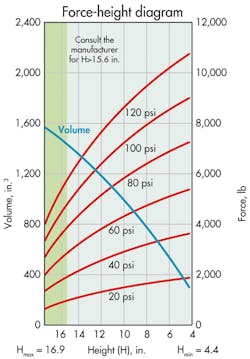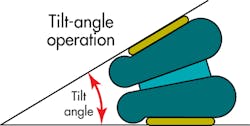Air springs are rubber/fabric bellows that support and contain a column of compressed air. These single-acting pneumatic actuators have been used for more than 50 years across wide-ranging applications, including off-highway and agriculture equipment, trains, and in-plant machines like presses, web tensioners, and lift tables. Over that time, they’ve developed a reputation for durability, longevity, and requiring little maintenance, and they often cost significantly less than conventional air cylinders, particularly in larger sizes.
Air-spring benefits
Thanks to a rugged and simple design, air-spring actuators offer a number of advantages over rod-type pneumatic cylinders — particularly where high forces are required under harsh and dirty operating conditions. For example, air-spring actuators work well in wood-processing operations that generate abrasive, coarse-grained particles. With rod-type pneumatic and hydraulic cylinders, particulates accumulate on the rod and accelerate seal wear, leading to premature leaks and failure. In comparison, air-spring actuators have no sliding seals. The stroke results from deformation of the unit’s rubber bellows wall that keeps dirt and other contaminants outside.
And because they have no dynamic seals, the design eliminates static friction and the “stick-slip” effect. The actuators respond immediately and uniformly to even small variations in pressure, and they operate on oil-free or lubricated compressed air.
Depending on the type, air-spring actuators can generate motion through arcs of up to 30°. This lets designers avoid costly connecting elements and articulated constructions when nonlinear movement is required. They also tolerate minor lateral displacements with no ill effects. Such flexibility compensates for inaccuracies in machine assemblies.
Actuator construction
Air-spring actuators are fabricated and appear much like automobile tires, with inner and outer elastomeric plies and fabric reinforcements in between. Standard units have a four-ply design consisting of an inner elastomer liner, two layers of cross-ply cord fabric (polyester or polyamide) at opposing bias angles, and an outer elastomer coating. Optional elastomers and fabric-reinforced designs are available for pressures exceeding 174 psi (12 bar).
Three different elastomers are generally used, with material selection based on several factors:
• Natural rubber is well suited for standard, general-purpose air actuators operating at temperatures from –76 to 158˚F (–60 to 70˚C).
• Chloroprene rubber (neoprene) resists environmental factors like weathering, ozone, UV, and aging; is flame retardant; and has limited resistance to mineral oils. It operates in temperatures from –22 to 194˚F (–30 to 90˚C).
• Epichlorohydrin (ECO) rubber provides high sustained-heat resistance and stands up well to mineral oils, fuels, steam, and water. It’s often used around aggressive media in the paper-producing and chemical industries. Temperature range is from –4 to 266˚F (–20 to 130˚C).
The flexible elastomer/fabric material is crimped to upper and lower bead plates, or bolted to a mounting surface with bead rings, to seal the actuator. Crimped bead plates come in either zinc-plated or stainless steel. Prior to vulcanization, the four material plies are wrapped around a steel core or ring placed on the ends of the assembly. After vulcanization, the bead plates are crimped around this steel ring and the bellows material, forming a permanent seal.
For air actuators with bead rings, one type has aluminum, mild steel, or stainless-steel bead rings on both sides of the molded bellows, each with threaded holes. The ring fastens through clearance holes in a flat mounting surface with a bolt or threaded stud and nut. Another version has aluminum bead rings with clearance holes for stud bolts on both sides of the molded bellows. The rings come premounted and with a set of knurled screws, nuts, and washers. These fasten to a flat mounting surface to form a tight seal. Generally, ContiTech recommends bead-ring-style actuators for larger-diameter bellows.
Actuator types
Air springs are classified as either convoluted or rolling-lobe designs.
Convoluted actuators are analogous to a rubber bellows with one, two, or three convolutions in the flexible member. More convolutions equate to a longer stroke length. Double and triple-convoluted components have a “girdle ring” or belt ring between convolutions for lateral stability and to permit longer strokes. In this design, force output changes with height because effective area changes; thus, as the stroke gets longer, effective area gets smaller which, in turn, reduces output force.
Convoluted air springs are used as either actuators or vibration isolators/dampeners in many industrial and mobile applications. As industrial actuators, for example, they are found in conveyors as gates or stops, paper mills for providing calender tension, and in lift tables for general manufacturing and material handling. In mobile equipment, they lift truck axles and apply tension to rubber tracks on construction and agriculture vehicles. As dampeners, they are filled to a set pressure to isolate vibrations of machinery like power-gen sets, large air compressors, and medical equipment in operating rooms.
Rolling lobe, or “piston-style” air springs also use a multi-ply, elastomeric/fabric material as a flexible rolling element. It is permanently crimped to a top plate and bump stop, or piston. As the rolling lobe retracts, it rolls onto itself over the piston. This keeps the effective area relatively constant throughout the entire stroke so force output stays fairly uniform. Maximum stroke is limited by the rolling-lobe’s length.
Rolling-lobe air springs primarily serve as vibration isolators or dampers in mobile applications. Typical uses include on-highway heavy-duty truck-axle suspensions, vibration dampeners for agricultural boom implements like seeders and sprayers, and tractor and skid-steer suspensions.
Another version is the sleeve-type rolling-lobe air spring. Its fabric-ply material is permanently press-fit to thermoplastic connecting parts by metal crimp rings. Like other rolling-lobe actuators, the effective area remains relatively constant as it extends and retracts, thus maintaining near-uniform force output throughout the stroke.
Sleeve-type air springs are used in seat and cabin suspensions in buses, heavy-duty trucks, and agricultural and construction machinery. They also serve as actuators to apply constant loads in agricultural-seeding machines.
While both designs are durable, convoluted bellows have a higher cycle life. They are generally rated for 6 million cycles, versus 2.5 million cycles for rolling-lobe air springs. (Because the rolling lobe contacts itself as it moves, this causes friction and faster wear over time, compared to convoluted designs.)
In addition, convoluted bellows have a lower minimum height, as they do not have a bump stop (piston). Convoluted bellows permit longer strokes and also have higher, more-linear spring rates — closer to that of mechanical springs. The rolling-lobe style has a more-constant spring rate and effective area. However, an advantage of rolling-lobe actuators is that the piston can be tapered in either direction to increase or decrease the spring rate. Finally, because they have more components and a more-complex design, rolling-lobe air springs tend to cost more than the simpler convoluted-bellows style.
Designing with air springs
Here are some machine-design tips when using air springs.
1. Select the right type.
First decide how the air spring will be used, as an actuator or vibration isolator.
Actuator. Main selection factors include: stroke length, output force, and return force. The maximum attainable stroke is the difference between the maximum and minimum height; the operating stroke length can be anywhere in between. Engineers can increase overall stroke by stacking two or more actuators with mounting plates and lateral guides; or by using a mechanical advantage such as a scissors mechanism. Given that effective diameter and area can change with operating height, and that the force exerted by an air actuator decreases progressively with stroke, designers must check the manufacturer’s force/stroke data for a given bellows to ensure it exerts enough force at the end of stroke, given the available air pressure.
Because air actuators function like a single-acting cylinder, it takes a return force to restore the actuator to its compressed height. This force differs for each design. Verify requirements by consulting manufacturers’ catalogs or technical data sheets that relate an air spring’s force, pressure, volume, and height.
Vibration isolator. Basic considerations include: load or total weight, number of mounting points, recommended operating height, degree of isolation, and operating pressure.
There should be sufficient load-bearing capability to compensate for asymmetric load distribution or excess weight. Note that air isolators are designed to absorb vibration-induced dynamic loads. They support loads using variable internal pressure, thus static compression is not comparable to that in steel or elastomeric springs. Adjusting operating pressure compensates for changes in compression caused by varying loads, so isolators should be used at the recommended operating height to ensure optimum isolation and lateral stiffness.
Vibration isolation is only possible if the exciting frequency is at least 1.4 times greater than the respective natural frequency. Consult graphs that plot exciting frequency versus natural frequency for each isolator to determine the degree of isolation. Finally, technical data sheets specify the required operating pressure in relation to the load and operating height for each size of isolator. As a rule, operating pressure should be between 58 and 87 psi (4 and 6 bar). And check that the on-site air pressure is sufficient, taking into account fluctuations and pressure drops in the air-delivery system.
2. Size the actuator.
When sizing an actuator, rely on a specific air spring’s engineering specs and account for: main dimensions, connecting dimensions, and force-height and volume relationships.
Engineering drawings show mounting dimensions, connecting dimensions, maximum diameter, and minimum required mounting space. For parameters like maximum height, force output, internal volume, and required air pressure, rely on force-height diagrams. If pressure, operating height, and mounting-envelope dimensions are known, then review the technical data sheets to find components that fit the design requirements. When using air springs for vibration isolation, the data sheets show applicable design characteristics such as pressure, force or load, spring rate, and natural frequency.
Online sizing and selection tools can streamline the design process. For example, ContiTech’s Online Industrial Air Spring Catalog lets users input operating parameters and it generates a list of suitable products for both actuators and isolators.
Mounting and operating considerations for air-bellows actuators include: down and up stops, tilt angle, lateral guidance, air consumption, installation space, mounting surface, lateral offset, and maximum pressure. Here are some guidelines:
► Air actuators must have external stops at the ends of stroke. Operating without them can damage the actuator and machine, as well as risk personal injury.
► The maximum permissible tilt angle varies with the type and kinematics of the application, but here are approximate allowable angles for different air springs:
Single convolution: 10 to 20°
Double convolution: 15 to 25°
Triple convolution: 15 to 30°
Rolling lobe: approximately 15°
Sleeve type: approximately 15°
► Actuator stability can vary greatly and depends on the type, size, internal pressure, and operating height. Because of this, lateral guides are advisable and often included in the overall design.
► The outer diameter of a convoluted air actuator is larger than the effective diameter. Thus, calculate air consumption using the volume curve from a technical data sheet, not the effective area and stroke.
► Installation space must allow for changes in actuator diameter over the entire stroke so that the bellows do not rub against any machine surface or itself, or suffer mechanical damage.
► Use the actuator’s entire mounting surface to ensure uniform force distribution. If this is not possible, using at least two-thirds of the support area is a must.
► Because the elastomeric-fabric plies are flexible, these actuators permit the top and bottom plates/piston to be slightly out of alignment. However, misalignment should not exceed 1.2 in. (30 mm) for triple convolution types, 0.79 in. (20 mm) for double convolution, and 0.39 in. (10 mm) for single convolution air springs.
► For standard products, operating pressure should not exceed 116 psi (8 bar); special air actuators with additional reinforcement can extend maximum operating pressures to 232 psi (16 bar).
4. Adhere to some pneumatic best practices.
Because these components are rodless and free of moving parts, air cleanliness is not a major concern as long as airborne vapors are chemically compatible with the elastomeric inner lining. As a best practice, however, experts recommend the pneumatic system use both particulate and coalescing filters to remove aerosols.
After determining the required volume to actuate the bellows, calculate the necessary valve, tubing, and fitting sizes. There is essentially no limitation on speed, except for overall control of the machine and system kinetics and kinematics. Basic limitations on speed will depend on the port and tubing sizes and pressure drops in the system.
Finally, air-spring selection, application, and use often require technical expertise. For that reason, it’s recommended to consult with an experienced specialist or application engineer.
Air springs are available in a broad product range and as customized individual designs, from a number of reputable manufacturers. ContiTech, for instance, makes air springs with diameters ranging from 2.36 to 39.37 in. (60 to 1,000 mm) and strokes to 19.69 in. (500 mm). At standard pressure of 116 psi, they have lifting power of 112 to 98,915 lb.
